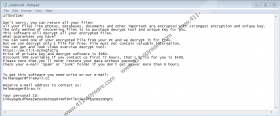Reha Ransomware Removal Guide
Reha Ransomware is the infection that is responsible for adding the “.reha” extension to the files you can no longer open normally. Photos, videos, documents, and other personal files are encrypted by this malware, and once that is done, the files appear to be lost because decrypting them manually is impossible. The good news is that this malware is part of the STOP Ransomware family (other threats that belong to it include Nbes Ransomware, Hets Ransomware, Kodc Ransomware, and many others), and a free decryptor was created by malware researchers. Whether or not you will be able to use the decryptor to restore your files depends on how they were encrypted. If you choose to install this tool, do your research, and be careful not to install something that only poses as a decryptor. The last thing you need is to invite more threats to your vulnerable system. Of course, while the decryption of your personal files might be something that you are most worried about, the removal of the infection is also very important. Do you know how to delete Reha Ransomware?
Once Reha Ransomware slithers into the targeted operating system, it immediately encrypts files. This infection should not encrypt any system files, and that should ensure that your system continues to run normally. This is very important for the infection because if you could not boot your system, the ransom note could not be introduced to you. This note is represented using the “_readme.txt” file that is originally dropped to the %HOMEDRIVE% directory along with a folder named “SystemID.” Besides these components, the infection also drops an .exe file with a random name to a unique folder in the %LOCALAPPDATA% directory. Of course, the most important is the .txt file because it introduces the instructions that the attackers behind Reha Ransomware expect all victims to follow. The ransom note suggests that files cannot be restored without a decryption tool and a unique key that, allegedly, only the attackers can provide. To get the tool and the key, you are supposed to send a message to helmanager@firemail.cc and helmanager@iran.ir and then pay a ransom of $980 (or $490 if paid within three days).
Even if the ransom sum was smaller, we would not recommend paying it because we do not believe that the attackers behind Reha Ransomware would ever give you a decryptor in return. They can promise you to decrypt files, but they cannot be held accountable, which gives them the freedom to do whatever they want. This is why a free decryptor is a true savior. If the tool does not work, not all is lost. You might have copies of your most important files stored outside the infected computer, in which case, you can remove Reha Ransomware and then replace the corrupted files. If you do not have backups, make sure you start creating backups after the removal of the threat. Even if you reinstate full-time Windows protection, you can never be too careful when it comes to malware, and it is always better to be safe than sorry, right? Of course, implementing reliable security software is just as important.
Have you thought about installing anti-malware software? If you install it, you will not need to remove Reha Ransomware manually because the software will perform removal automatically. Beyond that, it will also safeguard the system to keep it protected against malware attacks in the future. Of course, you have to do your part as well. If you do not want to be tricked into letting infections in yourself, you have to be cautious about the files you download and execute, the emails you interact with, the links and ads you click on, the messages you respond to, and the updates you skip or postpone. What about manual removal? You can try deleting Reha Ransomware manually if you can locate its launcher. If you can do that, it should be easy for you to eliminate the remaining components using the guide below.
How to delete Reha Ransomware
- Locate the .exe file that executed the malicious threat.
- If you can find the malicious file, right-click it and select Delete.
- Tap Win+E keys on the keyboard to access File Explorer.
- Enter %LOCALAPPDATA% into the quick access field at the top.
- If you can identify a folder with a random name that belongs to ransomware, right-click it and select Delete.
- Enter %HOMEDRIVE% into the quick access field at the top.
- Right-click and Delete a file named _readme.txt and also a folder named SystemID.
- Exit File Explorer and then Empty Recycle Bin.
- Employ a malware scanner you trust to check if your system is clean or if leftovers need to be dealt with.
Reha Ransomware Screenshots:


